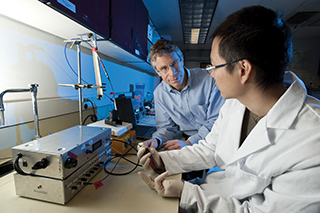

Tech transfer on the rise
Eric Peterson //November 2, 2012//

Colorado’s universities are playing an increasingly active role in laying the groundwork for the state’s startup community, with an especially keen focus on cleantech.
Trent Yang, director of CU Cleantech, works with the CU Technology Transfer Office to help spin off startups and license cleantech developed at CU. “The university is a fairly significant driver of economic growth,” says Yang, citing companies like Sundrop Fuels and OPX Biotechnologies as recent success stories. “We help identify great technologies that can be useful in industry.”
Beyond catalyzing tech transfer, Yang wants to boost entrepreneurialism among students. Last year saw the inaugural CU Cleantech New Venture Challenge, a $100,000 business-plan competition, and the 2013 event is on the calendar for April. “The goal is to get students to be more entrepreneurial,” says Yang.
Will Vaughan, director of technology transfer at Colorado School of Mines, started in 2008. “Our first fiscal year, we had 11 disclosures (by faculty inventors),” he says. “Last year, we had 33.” Vaughan says Mines is unique because it receives nearly half of its research funding from industry, versus 3 percent to 5 percent at CU and CSU. “(Researchers) have this little kernel in the back of their mind to get it out there to market.” Faculty culture is key, he adds. “You can publish and patent at the same time. It’s not an either-or proposition.”
Grants of up to $35,000 are available from the Colorado School of Mines Research Foundation for proof-of-concept funding. Numerous cleantech concepts are in the pipeline now, says Vaughan. “This push for cleantech really came a couple of years ago,” he adds. “We’re just on the cusp of getting some of the interesting technologies out there.”
At CSU, Tim Reeser is vice president of CSU Ventures and executive director of the school’s cleantech “supercluster,” Cenergy. The latter entity came to be in 2008 when CSU identified three areas of expertise with a critical mass of research and at least 100 relevant faculty members. (The others are cancer and infectious diseases.)
“We’ve had five startups in clean energy,” says Reeser. “It’s one thing to say we started companies, but the majority of those companies need funding.” For this reason, CSU Ventures offers strategic seed grants and works to connect researchers and investors. “The thing I’m most proud of is we now have a vibrant ecosystem of investors and entrepreneurs,” says Reeser. “To create a job and make an impact requires more than just the university.”
One standout cleantech-transfer example that originated at CSU is Solix Biosystems, which recently closed on $31 million in Series C funding, but the pipeline is just as impressive: In its fifth year of seed grants, Cenergy doled out nearly $200,000 to accelerate the commercialization of 11 different technologies, spanning smartgrid technology to biofuels to energy policy.
One 2012 recipient was power-metering startup InGreenium, founded by Daniel Zimmerle, senior research associate at CSU. The $24,711 grant from Cenergy will pay graduate students to establish proof of concept. “We got the idea, but now we have to prove that it works,” says Zimmerle. “I think it would have died on the vine without the seed money.”


























